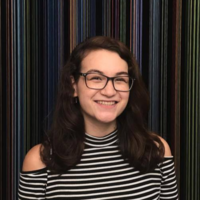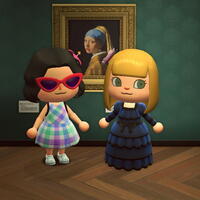More about The Blue Boy
- All
- Info
- Shop

Contributor
The Blue Boy was once the “most famous picture in the world.”
Truth be told, Thomas Gainsborough's most recognized painting isn’t that unique. The Blue Boy was greatly inspired by the work of Anthony Van Dyck. Gainsborough even used the same pose Van Dyck used in his painting George Villiers and His Brother Francis. The Blue Boy depicts Jonathan Buttall as a child, though X-rays have revealed the original painting was supposed to be a young man accompanied by a dog. Despite his fancy clothes Jonny wasn’t an aristocrat but the son of an ironmonger, an uncommon subject for portraits. Gainsborough clothed him in satin and lace all the same just to be ironic.
Like all great things, The Blue Boy was created out of spite. Gainsborough’s frenemy Joshua Reynolds, the first president of the Royal Academy, stated, “The masses of light should always be of warm, mellow colours; greys and greens should be used only to support and set these off.” Seeing that this was indeed the typical approach to portraiture, Gainsborough went ahead and painted a portrait that did the exact opposite. The sky-blues were used to color the subject, while earth-toned colors were transferred to the skies. He then gave the portrait to the subject Buttall who kept it until his bankruptcy. The painting was eventually sold in 1921 by art dealer Joseph Duveen to American railroad magnate Henry E. Huntington for £182,000 (~$728,000), making it the most expensive painting ever sold at the time.
As you might guess, the British weren’t too happy about their favorite painting being sold to an American. After its purchase the portrait was displayed in Britain one last time at the National Gallery where it attracted over 90,000 visitors before relocating to San Marino, California. The gallery director Charles Holmes was so upset that he scribbled “Au Revoir, C.H” on the back of the painting. Mr. Huntington probably wasn’t too pleased discovering that note.
The Blue Boy is now one of the main attractions at the Huntington Art Gallery where it stands opposite of the Thomas Lawrence portrait Pinkie. Despite the fact these two paintings were painted a quarter century apart by different painters, they are often mistaken to be by the same artist. The two portraits are associated together based on cliched gender norms- boy in blue, girl in pink. No wonder they served as set decorations in the suburban sitcom Leave It to Beaver.
While The Blue Boy is no longer the most talked-about painting in the world, it left a long-lasting cultural influence. It was the main inspiration behind F.W Murnau’s first film "Der Knabe in Blau" before he went on to make classic horror film "Nosferatu." More recently it inspired Django’s outfit in the Tarantino film "Django Unchained."
The Blue Boy was also responsible for inspiring artists’ career paths. American artist Robert Rauschenberg claimed that seeing The Blue Boy was his first encounter with art and the first time he realized somebody could actually be an artist. Painter Kehinde Wiley--whose portrait of Obama you might recognize--took art classes at the Huntington Library as a child and cites The Blue Boy as one of his biggest inspirations. It’s The Blue Boy’s artistically-done defiance of 18th century expectations that allows this simple portrait of a middle-class child in upper-class clothing to be so culturally accessible and inspiring even in the 21st century.
Sources
- Warner, Malcolm and Robyn Asleson. Great British Paintings from American Collections:Holbein to Hockney. New Haven, CT: Yale University Press, 2001.
- Lindsay, Jack. Thomas Gainsborough: His Life and Art. Chicago: Chicago Review Press, 1983.
- Muchnic, Suzanne. “Exorcising the Ghosts of Art,” LA Times, June 25, 1995. http://articles.latimes.com/1995-06-25/entertainment/ca-17044_1_blue-boy
- “The Blue Boy’s Transfer Begins in Secrecy.” The New York Times, January 26, 1992. https://timesmachine.nytimes.com/timesmachine/1922/01/26/109833152.pdf
- Bernal, Peggy Park. The Huntington: Library, Art Collections, Botanical Gardens. San Marino, California: The Huntington Library, 1992.
- Hanel, Marnie. “From Sketch to Still: The Spaghetti-Western Wit of Sharen Davis’s Django Unchained Costumes.” Vanity Fair, January 4, 2013.
- Kotz, Mary Lynn. Rauschenberg / Art and Live. New York: H. N. Abrams, 1990.
- Hobbs, Robert. “Kehinde Wiley’s Conceptual Realism” in Kehinde Wiley. New York: Rizzoli, 2012.
Featured Content
Here is what Wikipedia says about The Blue Boy
The Blue Boy (c. 1770) is a full-length portrait in oil by Thomas Gainsborough, owned by The Huntington in San Marino, California. Although both it and its creator are well known, the subject's identity is disputed.
Check out the full Wikipedia article about The Blue Boy















